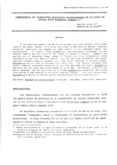| dc.contributor.author | Ulloa F., M. | |
| dc.contributor.author | De la Cruz, R. | |
| dc.date.accessioned | 2015-03-19T21:07:41Z | |
| dc.date.available | 2015-03-19T21:07:41Z | |
| dc.date.issued | 1990-03 | |
| dc.identifier.issn | e-ISSN: 1016-0469 | es_ES |
| dc.identifier.uri | https://repositorio.catie.ac.cr/handle/11554/5920 | |
| dc.description | 1 ilus. 3 tab. 10 ref. | es_ES |
| dc.description.abstract | En República Dominicana se cultivan anualmente 46.000 ha de frijol rojo con rendimiento promedio de 800 kg/ha, pero esta producción es insuficiente para cubrir demanda nacional. En algunas áreas la Rottboellia cochinchinensis (cebadilla) es la especie dominante pero no se conoce el valor de las pérdidas que causa. Para determinar estas pérdidas se hizo la presente investigación, en campos con alta infestación, y utilizando tratamientos que ofrecían cinco diferentes grados de control: tratamientos químicos, dos desyerbas (práctica de muchos agricultores) y tres desyerbas que ofrecen un mayor grado de control de la cebadilla. Los resultados indicaron que algunos de los tratamientos químicos selectivos al cultivo y la maleza pueden favorecer la dominancia de la cebadilla, la cual puede causar pérdidas hasta del 86% en los rendimientos de frijol. La práctica del agricultor, dos desyerbas, fue insuficiente para eliminar la competencia de la cebadilla, ya que los rendimientos se redujeron un 25% con relación al tratamiento con tres desyerbas. | es_ES |
| dc.description.abstract | In the Dominican Republic 46.000 ha of red beans are grown annually with a mean yield of 800kg/ha, however, this not sufficient to meet national demand. In certain areas Rottoboellia cochinchinensis (itchgrass) is the dominant species but the value of the losses it causes is unknouwn. Research was carried out to determine these losses int field with high infestation using treatments giving five levels of control: chemical herbicide treatmens, two manual weedings (commonly used by farmers) and three manual weeding to achieve greater Rottboella control than is achieved with herbicides. The results indicated that certain chemical treatments selective to the crop and weed can favour Rottboellia dominance and can cause bean yield losses of up to 86%. The farmers' practice, two manual weedings, was not sufficient to eliminate Rottboellia competition and yields were reduced by 25% compared to the three weedings treatment. | |
| dc.language.iso | es | es_Es |
| dc.publisher | CATIE, Turrialba (Costa Rica) | es_ES |
| dc.relation.ispartof | Manejo Integrado de Plagas y Agroecología Número 15 (Marzo 1990), páginas 1-12 | |
| dc.rights | info:eu-repo/semantics/openAccess | |
| dc.subject | ROTTBOELLIA COCHINCHINENSIS | |
| dc.subject | MALEZAS | |
| dc.subject | ESPECIES DOMINANTES | |
| dc.subject | COMPETENCIA BIOLOGICA | |
| dc.subject | DENSIDAD DE LA POBLACION | |
| dc.subject | ESCARDA | |
| dc.subject | CONTROL QUIMICO | |
| dc.subject | RENDIMIENTO DE CULTIVOS REPUBLICA DOMINICANA | |
| dc.subject | CYPERUS ROTUNDUS | |
| dc.subject | PHASEOLUS VULGARIS | es_ES |
| dc.title | Competencia de caminadora Rottboellia cochinchinensis en cultivos de frijol rojo Phaseolus vulgaris L. | es_ES |
| dc.type | Artículo | es_ES |
| dc.journal.issueNumber | 15 | |


